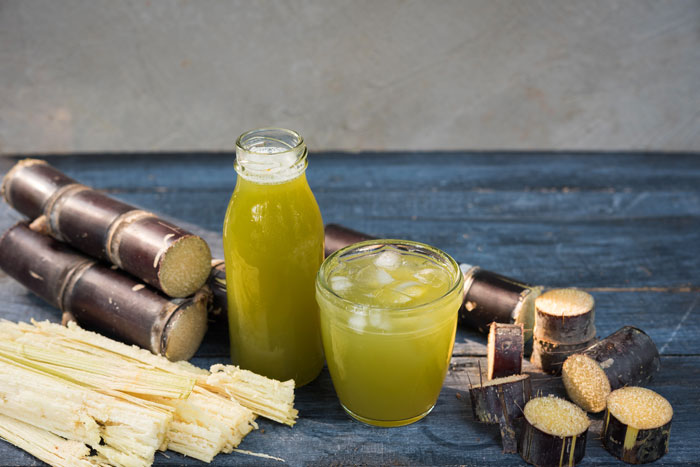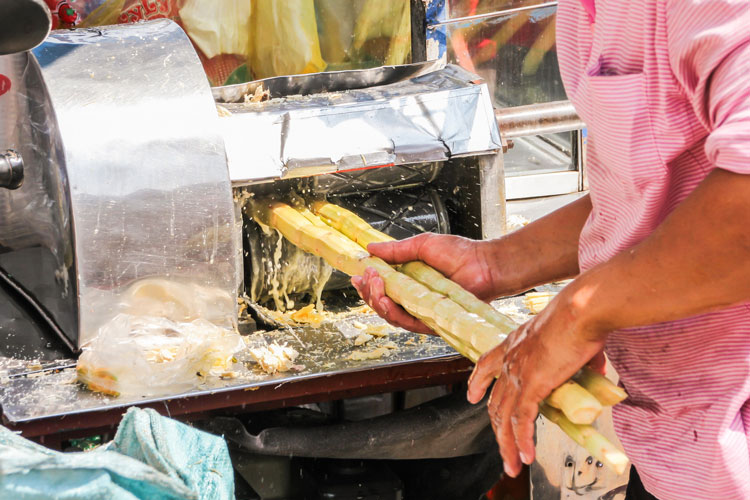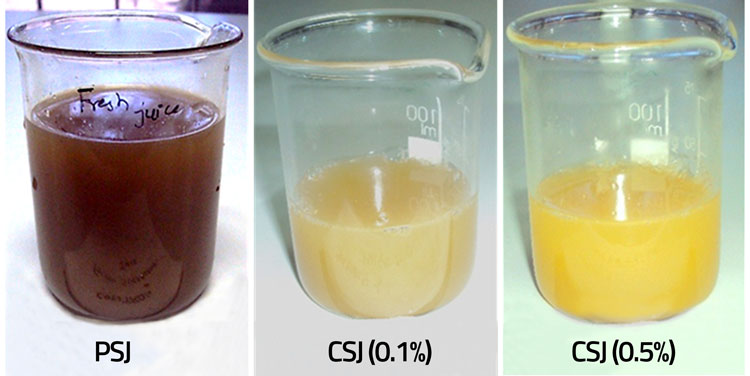Anti-browning agents in the valorisation of sugarcane juice
- Like
- Digg
- Del
- Tumblr
- VKontakte
- Buffer
- Love This
- Odnoklassniki
- Meneame
- Blogger
- Amazon
- Yahoo Mail
- Gmail
- AOL
- Newsvine
- HackerNews
- Evernote
- MySpace
- Mail.ru
- Viadeo
- Line
- Comments
- Yummly
- SMS
- Viber
- Telegram
- Subscribe
- Skype
- Facebook Messenger
- Kakao
- LiveJournal
- Yammer
- Edgar
- Fintel
- Mix
- Instapaper
- Copy Link
Posted: 21 November 2018 | Jyoti Nishad | 1 comment
Commercialisation of fresh sugarcane juice is restricted by the immediate deterioration that occurs after its extraction. Jyoti Nishad reports on new scientific techniques she has been using in a bid to solve the problem.


Fresh sugarcane (Saccharum species) juice is always relished for its sweet flavour and thirst-quenching properties. Moreover, the presence of appreciably high amounts of vitamins, minerals, organic acids and amino acids in sugarcane juice imparts health promoting effects. It has been valued since ancient times for its recuperative powers against jaundice and cardiovascular diseases, attributable to the presence in its make-up of primary and secondary metabolites. Moreover, polyphenols present in the juice possess anticancer properties and guard against the degeneration of cells.
Sugarcane juice is commercially recognised in processed products such as sugar, khandsari, gur and fermented products. At present, the availability of fresh sugarcane juice is confined to locally extracted juice for immediate consumption. A more commercialised technological approach is required, however, if the juice is to reach its market potential.
The commercialisation of fresh juice is restricted by the immediate deteriorative quality changes that occur after extraction. The high polyphenolic and sugar content, medium to low acidity (pH‑ 5.0 to 5.5) and high polyphenol oxidase (PPO) activity turn the juice brown and degrade the overall sensory quality. Moreover, microbial fermentation of the juice turns its taste sour within a few hours of extraction, making it unsafe for consumption.


Sugarcane extraction method
Traditionally, lime juice, ginger and curd are used for short-term inhibition of enzymatic activity, but long-term storage is still a challenge. Numerous methods focusing on extending the shelf life of sugarcane juice have been employed, either individually or in combination with other technologies.
At present, the availability of fresh sugarcane juice is confined to locally extracted juice for immediate consumption.
Heat inactivation of enzymes through blanching of raw materials; use of chemical preservatives (citric acid, ascorbic acid, sulphur dioxide, etc); use of lemon and ginger along with pasteurisation; freeze concentration; irradiation; use of pulsed electric field and supercritical carbon dioxide; ohmic heating and microwave heating; high hydrostatic pressure treatment; spray drying and freeze drying – all have been evaluated for their efficiency in inhibiting enzymatic and microbial spoilage. These conventional and non-conventional preservation technologies might significantly improve the juice’s storage life but they also impair the flavour and sensory experience offered by the juice. Anti-browning agents such as citric acid and ascorbic acid are thus widely used for short-term preservation with the aim of retaining the original taste of the juice as far as possible. This can be further complemented by low temperature storage.
Role of anti-browning agents in preventing spoilage
Two main factors contribute to the deterioration of fresh sugarcane juice: enzymatic browning and microbial fermentation. The enzymatic browning catalysed by PPO is the result of oxidation of mono- and diphenols to highly reactive compounds o-quinones. These compounds further polymerise to form brown-coloured pigments (melanin). Inhibition of oxidation of phenols to quinones using anti-browning agents could successfully prevent these colour changes. The widely used anti-browning agents, ascorbic acid and citric acid, have been shown to resist these changes through their ‘deactivation mechanism’.
The antioxidant Ascorbic acid (AA), or vitamin C, reduces browning in juices through averting the oxidation of diphenols to quinones. It also inhibits secondary oxidative reactions by reducing the quinones, causing a reduction in pH towards a more acidic range. This acidic pH further inhibits PPO activity, for which pH optima is generally 5 to 7.5. However, use of ascorbic acid poses some drawbacks, as during a long run of activity it exerts pro-oxidant effects. These post-processing effects are triggered by dehydroascorbic acid, which are oxidation products of AA resulting from irreversible reaction with intermediates, endogenous enzymes, iron and copper. Thus the development of ascorbic acid derivatives, 2- and 3-phosphate and phosphinate esters, which have increased stability, is now being practised.
Another anti-browning agent, citric acid, acts as a sequestering agent by chelating metallic ions, which can accelerate browning, complex formation (turbidity) and discolourations. Citric acid lowers the pH and chelates the copper at the active site of the enzyme, imparting dual inhibitory effect on PPO. This acidulant has been successfully used in many commercial food formulations to impart acidity or to enhance the keeping quality of final products and is often reported to show synergistic effect with other anti-browning agents.
Evaluation of quality changes in sugarcane juice
The inhibitory action of the chemical preservatives on sugarcane juice depends on many factors viz. type of food matrix, concentration used, inherent characteristics of the surroundings, synergy with other antioxidants, method of application, processing conditions etc. Different physical and chemical parameters, such as reflectance measurement (L* (lightness or darkness), a* (redness or greenness), and b* (yellowness or blueness)), turbidity, pH, acidity, microbial count and sensory evaluation, are generally taken into consideration while evaluating the efficiency of anti-browning agents.
A comparative study evaluating citric acid and ascorbic acid for their potential in retaining the quality of juice revealed the effect of concentrations on their activity. Among different concentrations of acids used (0.04%, 0.1%, 0.2%, and 0.5%), 0.5% of citric acid showed the most favourable results with high sensory acceptability of the juice. Results for colour values (L*, a* and b**), showed highest L* and b*, and low a* with 0.5% citric acid indicating increase in lightness and yellowness and corresponding decrease in redness of juice depicting insignificant change in fresh juice colour (Figure 1).


Figure 1: Sugarcane juice after six hours of low temperature storage. (PSJ – Pure sugarcane juice, CSJ – Sugarcane juice with added citric acid)
Turbidity, another important parameter of juice clarity, is known to be caused by colloidal and suspended particles (waxes, proteins, pentosans, gums, starch, silicate and soil) present in the juice. Evaluation of change in turbidity with increase in acid concentration revealed an inverse relationship between two, signifying a clearer juice at 0.5% concentration.
The results suggest the action of organic acid on absorption of colloidal matters and coloured compounds. These get precipitated and separated from juice by filtration, decreasing the turbidity of juice. Moreover, addition of organic acid directly affects the PPO activity by binding to active site and inactivating the enzyme, thus giving a good yellow to orange-yellow colour to the juice. Estimation of microbial load also provided comparative results for freshly extracted sugarcane juice and juice with citric acid (<3 log cfu/ml), revealing a significant reduction in microbial activity.
Finally, the sensory evaluation of juice supported the optimisation process for concentrations of acidulant. The sensory scores showed the role of overall acceptability of the juice in standardisation. Despite the fact that 0.5% concentration yielded best results with respect to colour of the juice, a lower concentration of 0.1% was optimised for imparting a balanced flavour, taste and colour to the juice.
Thus, a comprehensive shelf life of six hours was achieved for the sugarcane juice without altering its nutritional, microbial and sensory quality. These antioxidants in hurdle technology have the potential to arrest enzymatic and microbial activity. In addition, Generally Recognised As Safe (GRAS) status of these preservatives means a safe, quality product in its natural form for consumers. A framework has thus been created for the development of a commercialised technology to facilitate the year-round availability of sugarcane juice.
About the author
Jyoti Nishad is a food technologist and research scholar in the Department of Food Science & Post Harvest Technology, Indian Agricultural Research Institute, India. She is currently working on optimisation of extraction technologies for citrus peel polyphenolics and functionalisation of the food matrix.
Issue
Related topics
Ingredients, Natural, Quality analysis & quality control (QA/QC), Research & development, Shelf life, Technology & Innovation, Temperature control










We are interested this procedure for our process. It’s possible contact to author?